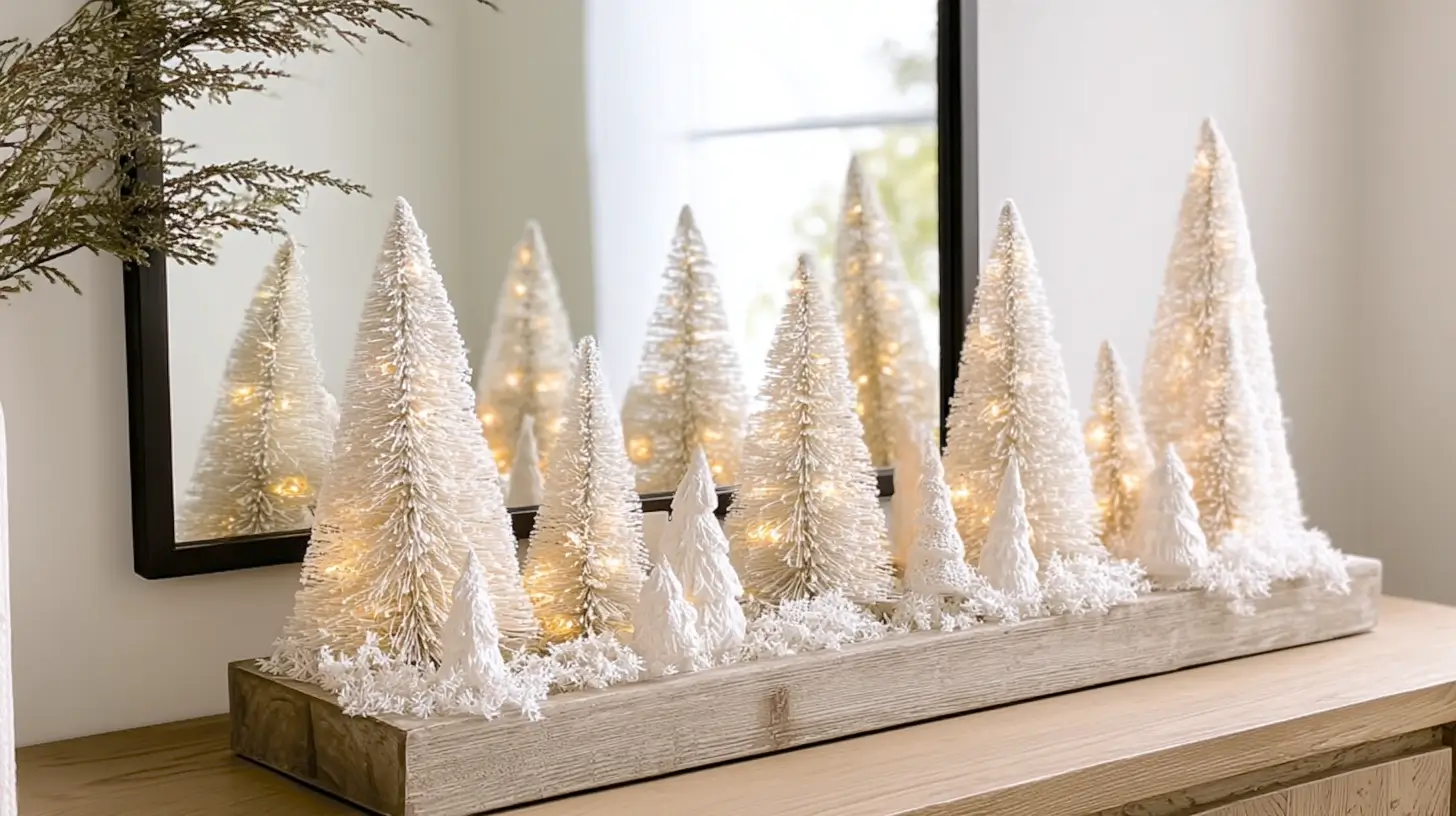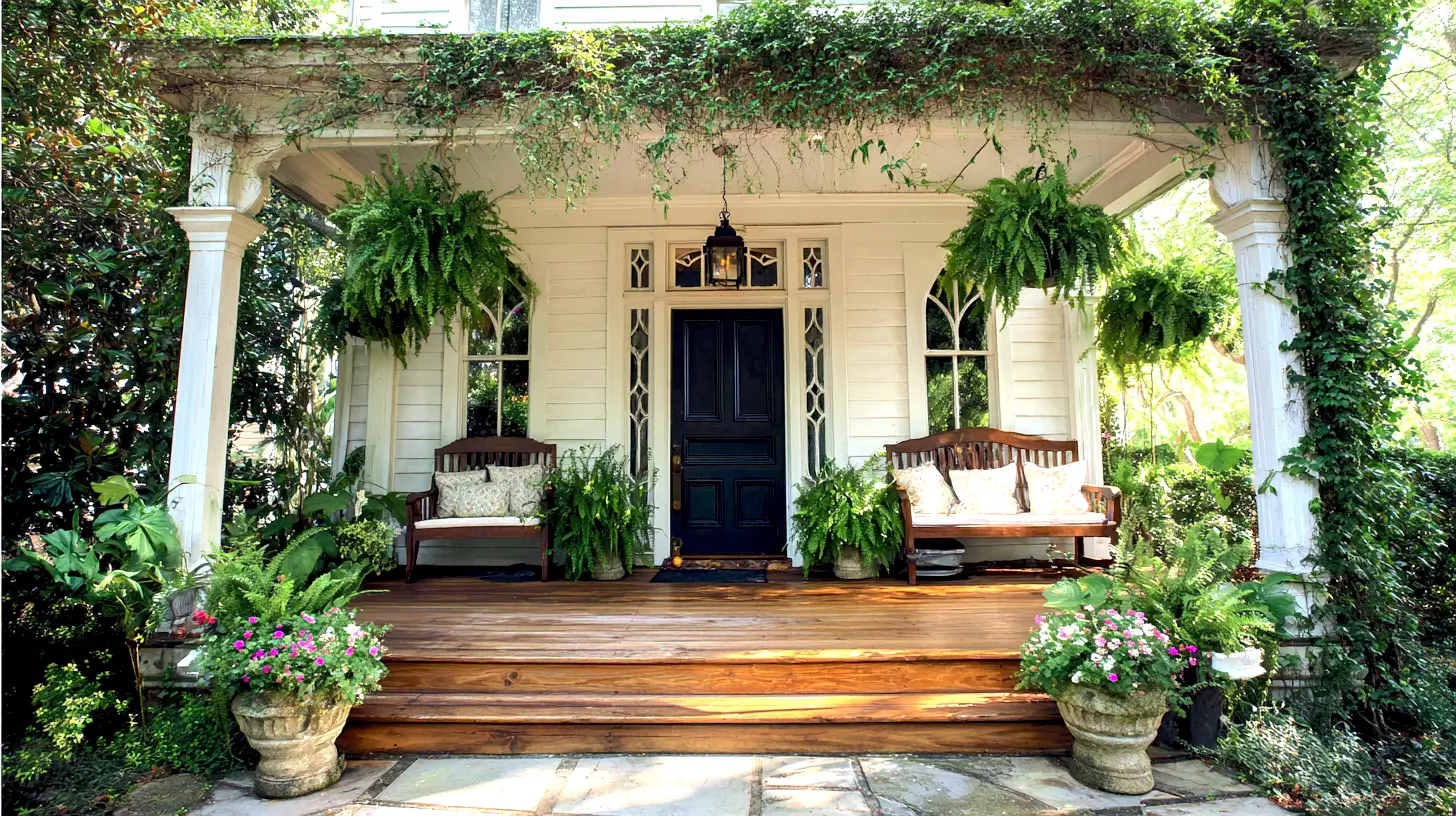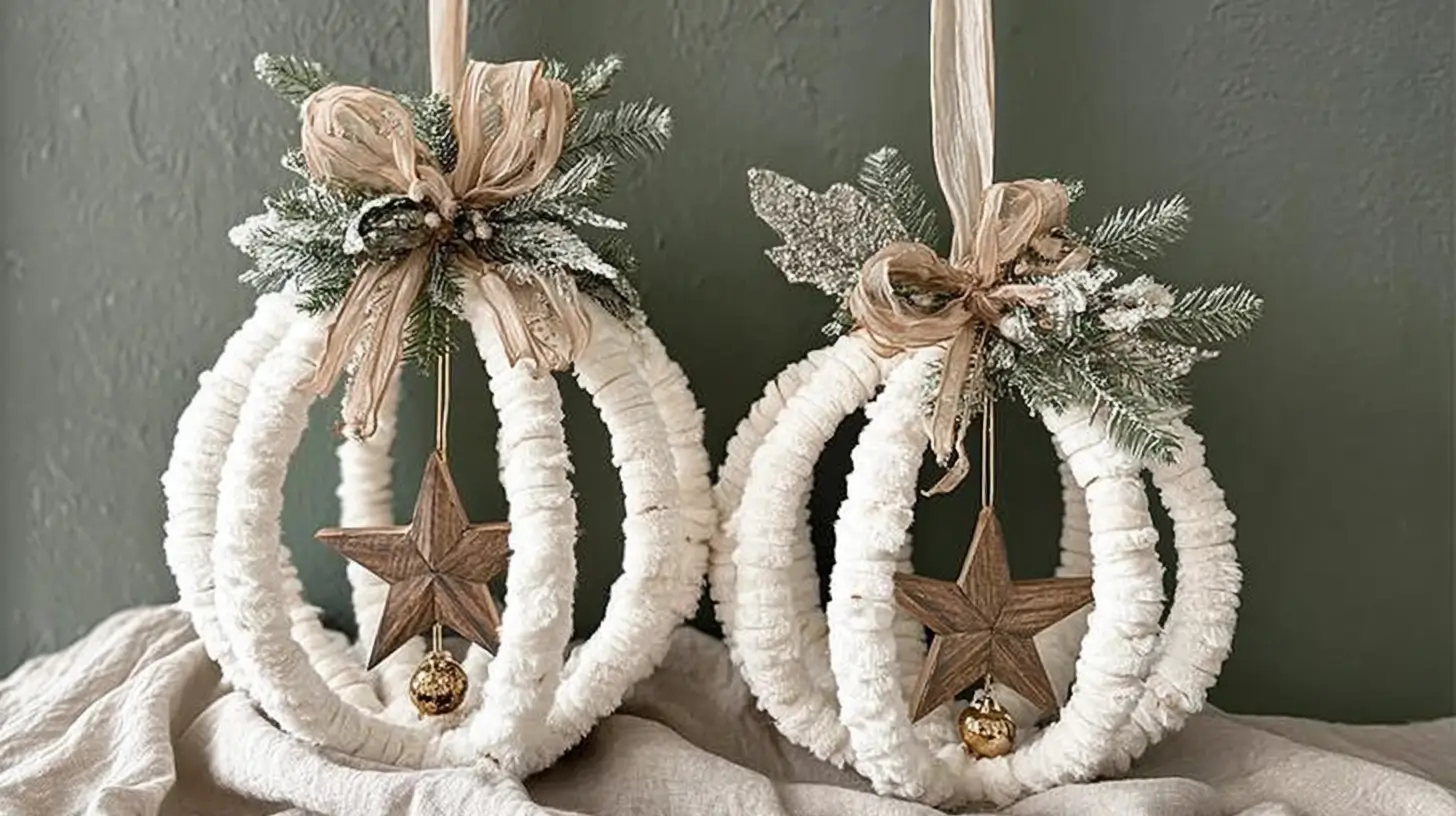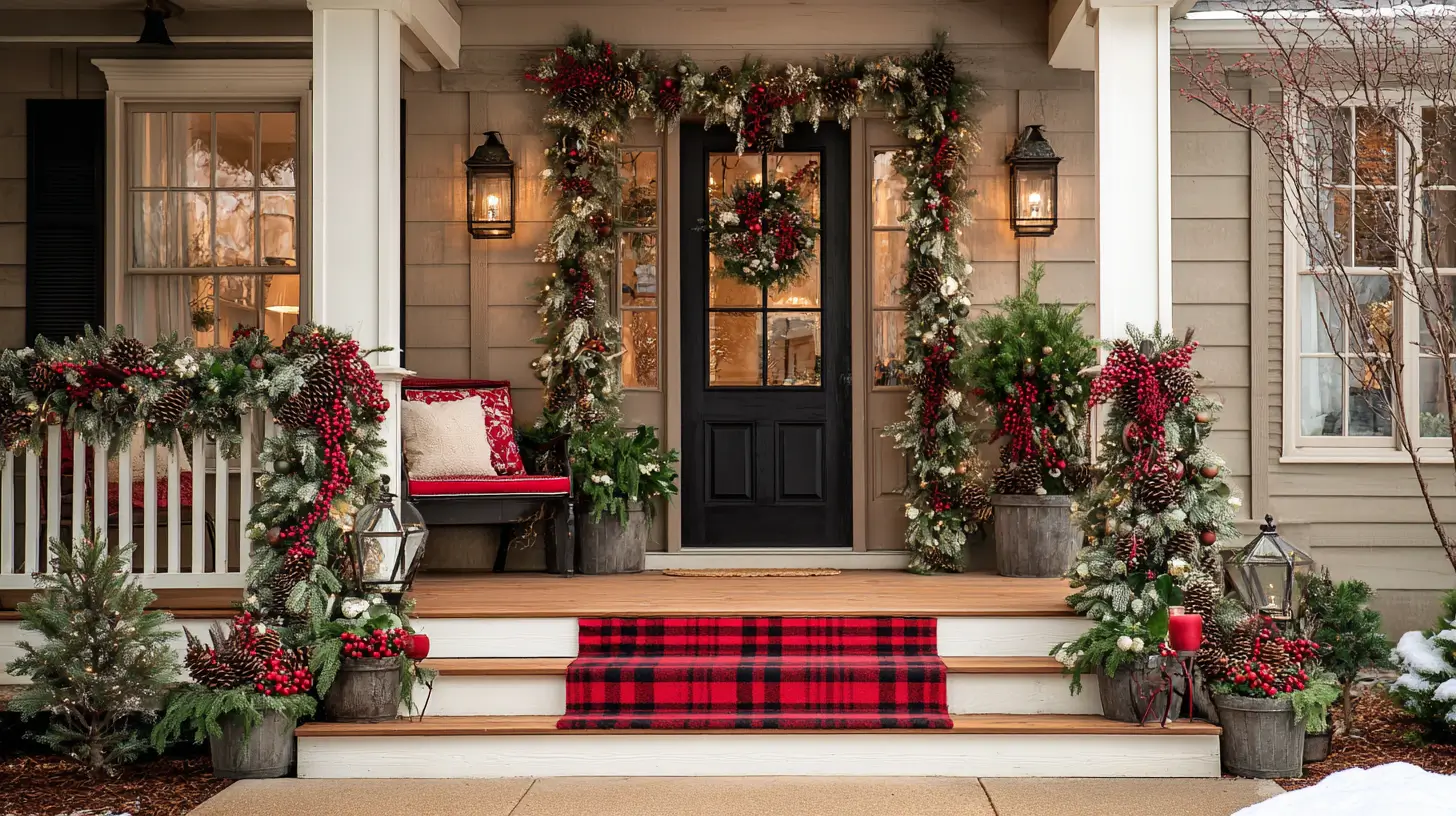When you think about your yard, you probably think about the big things. Maybe it’s the garden. Or the fence. Or that old tree that drops leaves everywhere. But there’s one part that gets overlooked a lot—and it shouldn’t. The walkway. It’s the thing you walk on every day. It leads people to your front door. It can even shape the whole feel of your yard. That’s why I pulled together the best cheap DIY walkway ideas fans like me can actually do—without blowing the budget.
Now, don’t panic. You don’t need to hire someone to do this. A big budget isn’t required either. I’m not talking about a backyard makeover. This is about simple paths that actually work and look cute too. I’m all about cheap walkway ideas diy style. No contractors, no stress, and definitely no emptying your wallet!
This post is full of easy, low-cost ideas to help you fix up your walkway without too much fuss. You’ll get real, practical tips. Nothing complicated. I’m talking about gravel, pavers, concrete, bricks, and more. If you’re working with a small space or just want to make a clear path through your yard, I’ve got you covered. We’ll talk about using things you already have or can get for next to nothing. Some of these ideas are even fun to do with kids.
Each section is packed with details so you can actually make this happen. You won’t be left guessing. Whether you want something modern, rustic, or just plain useful, there’s something here for you. We’ll also cover landscaping touches that make your walkway pop. The best part? You can mix and match the ideas that fit your space.
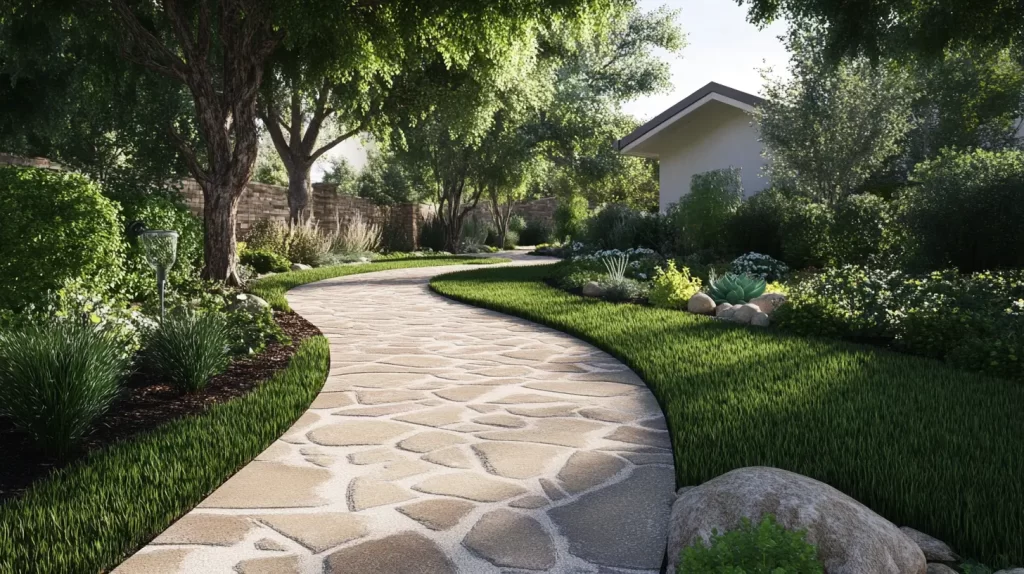
This site includes affiliate links; you can check the disclosure for more details.
Concrete Walkway Path on a Budget
Concrete is tough. It’s clean. It lasts a long time. And the best part? You can work with it yourself. There are plenty of ways to do a concrete path without spending a lot.
Let’s talk basics first:
- Use concrete mix from the store. Just add water.
- Make your own path mold using wood planks.
- Pour, smooth, and let it dry. That’s really it.
Now here’s where the budget part comes in. You can keep things super simple or get a little creative. One idea is to pour small sections instead of a full slab. Kind of like stepping stones. Leave grass or gravel between the pieces. It saves on concrete and still gives you a clear path.
Here are some more ways to cut costs:
- Use leftover concrete chunks from someone else’s project.
- Check Craigslist or Facebook Marketplace for free supplies.
- Break up an old sidewalk slab and reuse the pieces.
You can even add texture with things you have at home:
- Press in leaves for a nature look.
- Use a broom to give it grip.
- Stamp with cookie cutters or rubber mats.
If you want something decorative, stain it after it dries. You can get small containers of concrete stain in different colors. Just brush it on and let it soak in. It looks fancy without the fancy price tag.
Concrete paths are low maintenance too. Once it’s in, you don’t need to do much. It holds up through rain, heat, and whatever else the weather throws at it. It’s one of my favorite cheap walkway ideas diy projects that pays off long term.
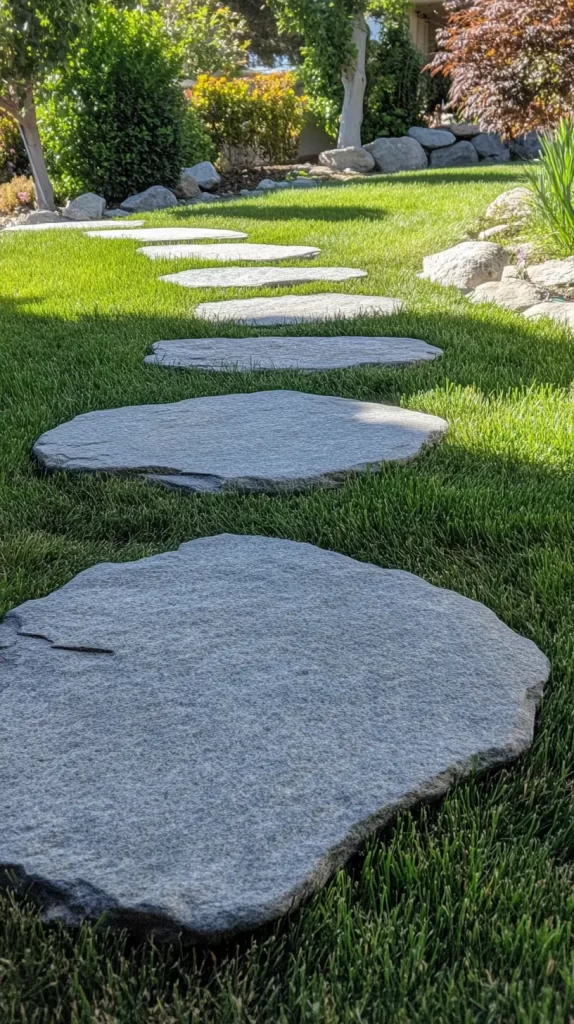
Cozy Outdoor Vibes Begin With DIY Cheap Walkway Ideas
When it comes to outdoor paths, comfort matters. Not just looks. You want something that feels nice to walk on. Something safe and easy to keep clean. And yes, something that fits your budget.
There are lots of outdoor walkway choices that won’t empty your wallet:
- Mulch paths – super cheap and soft underfoot.
- Flat stones – find them around your yard or local landscape shop.
- Pallets – break them apart and use the wood for planks.
Mulch is one of the easiest things to work with. You don’t need glue or tools. Just pour it and smooth it out. Plus, it smells kind of nice. Keep it in place with bricks, stones, or scrap wood.
Stepping stones work great too. You can space them out and fill the gaps with grass or dirt. It looks nice but still feels casual. If you want a woodsy look, go with natural stones. For a cleaner look, go with square pavers.
Pallet wood can be tricky but doable. Make sure the boards aren’t treated with harsh chemicals. Sand them down so you don’t get splinters. Then just lay them across the path space, with gravel or sand underneath for drainage.
You can also try mixing materials. A gravel path lined with bricks. Or mulch between stone slabs. Use what you’ve got and play around with it. Outdoor walkways don’t have to be boring or expensive. A few small changes can make the whole yard feel cozier. And you can do it all without hiring help.
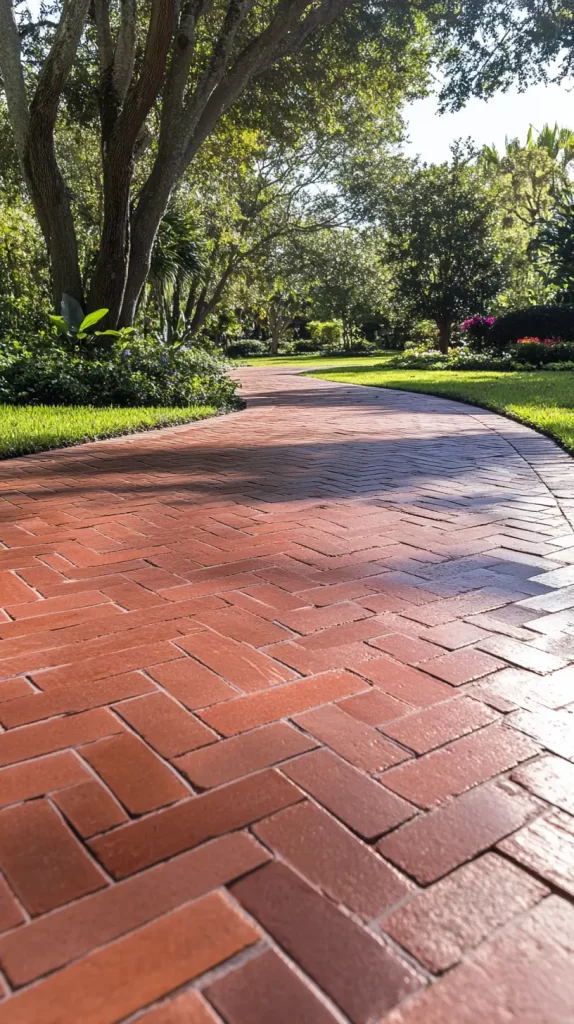
DIY Cheap Walkway Ideas With Pavers That Save You Money
Pavers are a great middle-ground option. They’re easier to work with than full concrete, but still feel solid and sturdy. The trick is finding a way to use them that doesn’t cost a lot.
Start by picking your pavers. You can:
- Buy secondhand ones online.
- Ask local stores for broken or leftover pavers.
- Use bricks or concrete blocks as substitutes.
Once you’ve got your materials, think about the design. A straight line is the easiest. But you can also go curved or staggered if you want something playful. Just remember to level the ground first. Uneven pavers are not fun to walk on.
Ways to save:
- Use sand instead of cement underneath.
- Leave spaces between pavers to save on quantity.
- Fill gaps with gravel or grass.
Here are some easy layout styles you can try:
- Straight line (good for tight spots)
- Basket weave (nice for a wider look)
- Herringbone (looks fancy but is easy to lay)
Don’t forget the edge. You can border your paver path with:
- Landscape edging strips
- Bricks on their side
- Old boards or logs
That border keeps everything in place. It also makes the path look more finished. And honestly, it makes your yard look like you hired someone—even though you didn’t.
When it comes to cheap walkway ideas diy projects, pavers are a win. They give you a lot of freedom to create your own style. And you don’t need any special tools to pull it off.
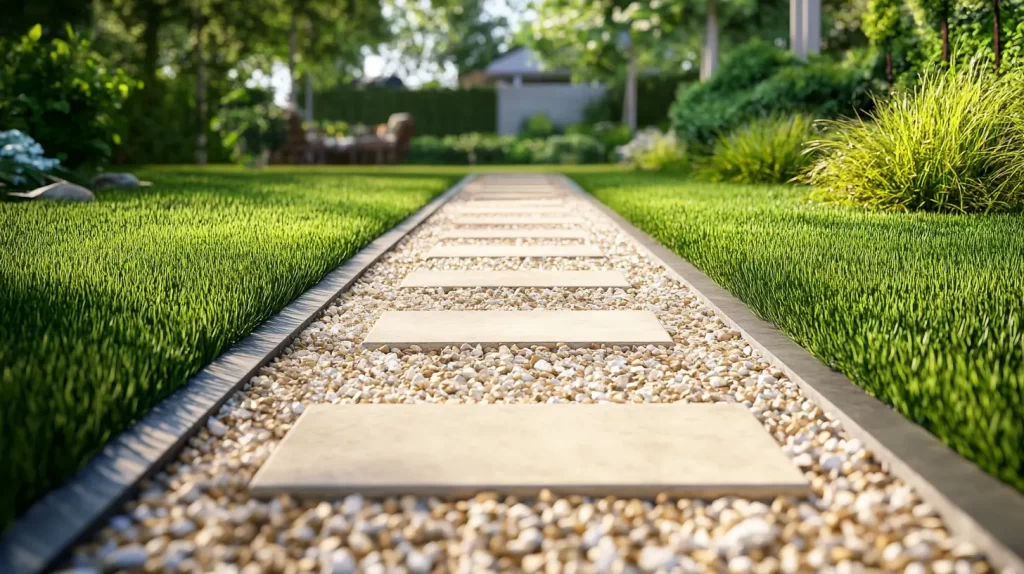
Gravel Walkway that’s Easy and Affordable
Gravel is one of the cheapest ways to make a path. It’s fast, it’s easy, and it drains well. You don’t have to do much prep work either.
Here’s what you need:
- Landscape fabric
- Gravel (pea gravel is best for walking)
- A rake to spread it out
First, clear the area. Get rid of weeds and big rocks. Then lay down the fabric. That helps keep weeds from coming back. Next, dump the gravel on top and spread it out. Aim for two to three inches thick.
A few things to know:
- Use edging to keep the gravel in place.
- Rake it now and then to keep it even.
- Add a fresh layer once a year if it thins out.
You can find gravel at home improvement stores or local landscape yards. Sometimes you can even find it for free online. People who finish projects often give away their extras.
Want to make it cuter? Add a border. Try:
- Red bricks
- Wood logs
- Big stones from your yard
You can also mix in stepping stones or large flat rocks. That gives the path a cleaner look and helps if the gravel shifts around. It’s a great combo.
Gravel paths are one of the easiest cheap walkway ideas diy fans can pull off in a weekend. No mess. No stress. Just a solid path that works and looks nice.
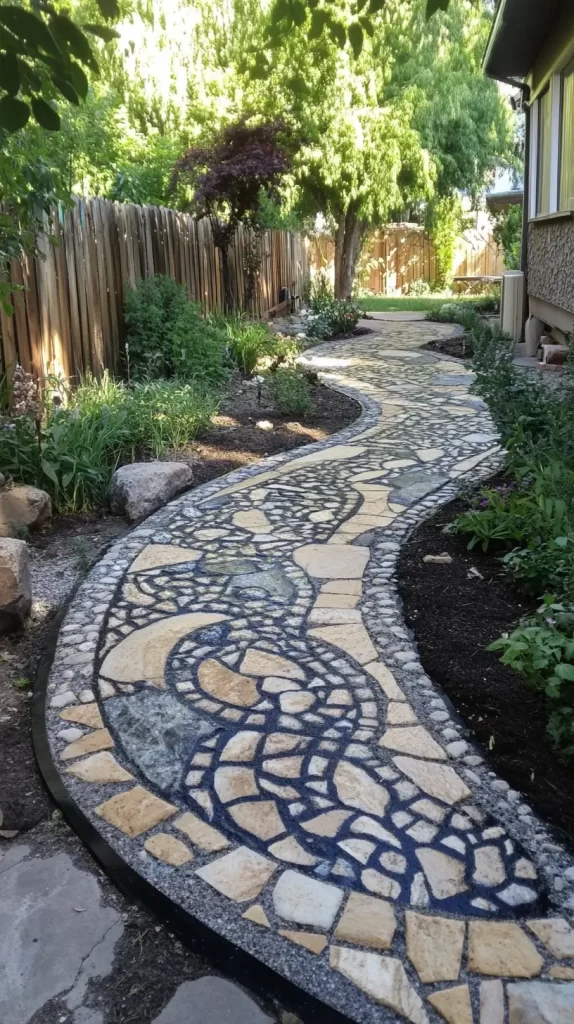
Cheap Garden Path Ideas for Your Yard
A garden path doesn’t have to be fancy. It just needs to lead the way. Whether it goes through flowers or vegetables, it can be simple and pretty too.
Here are a few cheap garden path ideas that work great:
- Wood slices – use old tree stumps or logs
- Stone chunks – leftover rocks from other projects
- Cardboard base – layer mulch on top to block weeds
Wood slices are cute and give a cottage feel. You can cut them from downed limbs or buy them cheap. Just make sure they’re not too thin. Thicker slices last longer.
Stone chunks work like puzzle pieces. You don’t have to match them. Just lay them in a way that feels right. Use dirt or sand to hold them steady.
Want to keep it simple? Lay down cardboard where you want the path. Then cover it with mulch. That’s it. The cardboard stops weeds. The mulch makes it soft to walk on.
If you want extra charm, line the path with:
- Shells
- Flower pots
- Painted rocks
Kids love to paint rocks for garden paths. It adds color and makes the path feel personal.
Garden paths don’t need to be straight. Let them curve with your plants. That gives your yard a cozy, natural feel. With a little creativity, you can pull off these cheap walkway ideas diy style without much time or money.
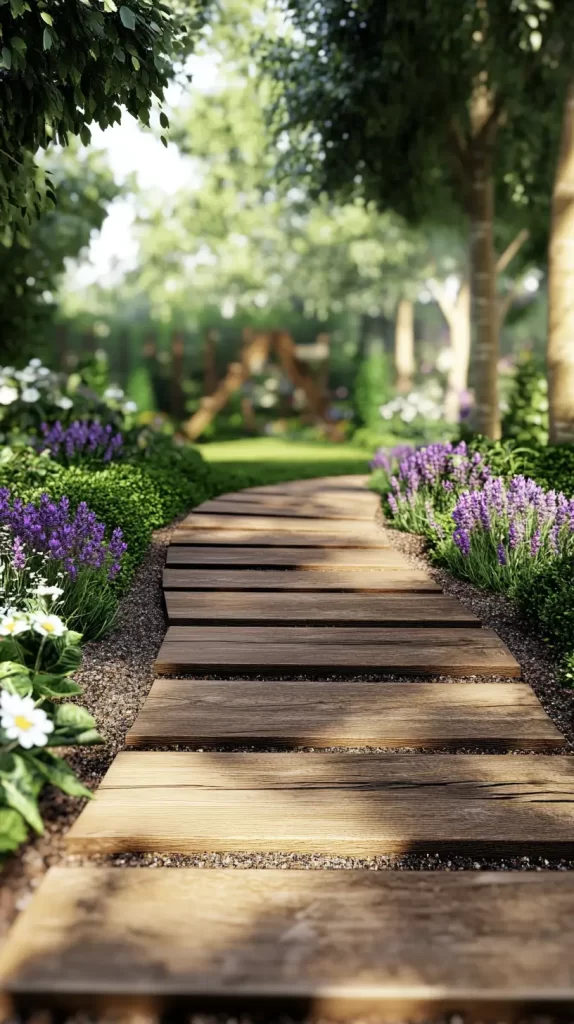
Easy DIY Walkway Ideas
Sometimes simple is best. You don’t need to overthink it. If you just want a basic path to get from point A to B, these easy walkway ideas are perfect.
Try these:
- Stepping stones in grass
- Flat rocks with sand base
- Wood planks on top of gravel
Stepping stones are one of the easiest. Place them about a foot apart. That gives a natural stride. You can buy them or make your own using molds and concrete mix.
Flat rocks work well if you have them lying around. Just dig a shallow hole and set the rock in. Tap it down to level it out.
Wood planks are another quick fix. Lay them on top of gravel or dirt. Use treated wood so it doesn’t rot. Or seal it yourself to save money.
Even broken things can become a walkway:
- Old tiles
- Concrete blocks
- Brick pieces
Just arrange them in a row and press into sand or dirt. No glue or tools needed.
Here’s a fun extra tip. Use glow-in-the-dark paint on stone or wood. It gives your path a soft glow at night. Handy for front yards or garden areas.
These are all great options for cheap walkway ideas diy style. They’re fast, easy, and work for almost any space.
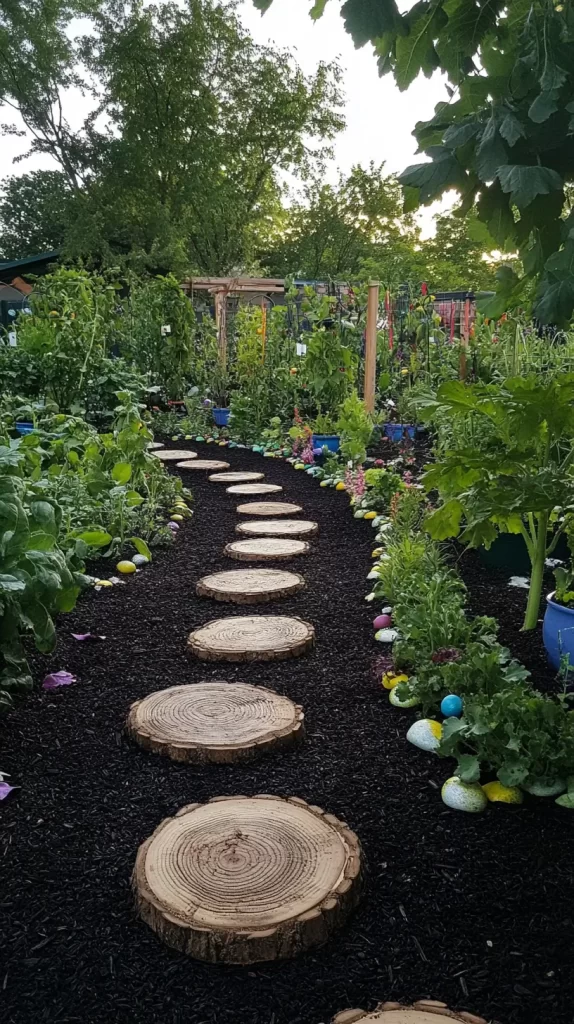
Walkway Landscaping That Makes a Big Impact
You don’t have to be a pro to add a few pretty touches around your path. Walkway landscaping doesn’t have to cost much. Just a few changes can make your path look polished.
Here are some cheap tricks:
- Add solar lights along the edge
- Plant low flowers or herbs on each side
- Use small rocks to frame the border
Solar lights are cheap and easy. You just stick them in the ground. No wires. No hassle. They light up your walkway at night, which is great for safety too.
Planting along the edge is a nice touch. Try:
- Lavender
- Creeping thyme
- Marigolds
These stay low, smell good, and don’t need much care. They also help keep the path from looking bare.
You can also use what’s already in your yard. Dig up plants that spread too far and move them next to the path. Free landscaping.
Another idea is to create contrast. If your walkway is light, use dark mulch around it. If it’s gravel, edge it with red bricks. Contrast makes everything pop.
Add a bench or a bird bath nearby if you want a cozy corner. Even a simple chair can make a path feel like part of a plan.
You don’t need to go big with walkway landscaping. A few cheap changes can pull the whole look together.

Brick Walkway Ideas That Feel Timeless
Bricks are classic. They’ve been used for walkways forever, and they still look great today. Best part? You don’t need a huge pile of them. Just enough for a path.
You can lay them:
- Side by side in a row
- In a zigzag pattern
- In a herringbone layout
A simple straight line works well. But if you want more style, the herringbone pattern looks great and isn’t hard to do.
Here are some brick walkway tips:
- Use sand instead of cement
- Dig a shallow trench first
- Keep a rubber mallet handy to tap them down
Want to save money? Look for used bricks. People give them away online all the time. Or check local building supply yards for seconds.
Make it fun by mixing red and gray bricks. Or turn some bricks on their side for a built-in border. You can even write on them with paint pens to make them personal.
Bricks work with lots of yard styles. Rustic, tidy, old-fashioned—it all works. You don’t need a ton of tools, just a shovel, some sand, and a little time.
If you’re looking for cheap walkway ideas diy that have charm and last a long time, brick is worth a try.
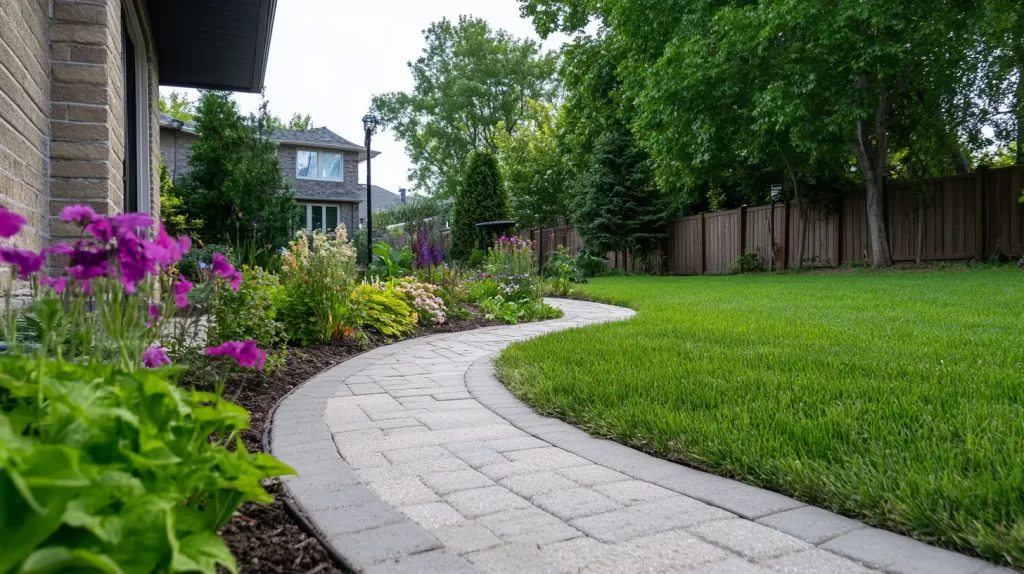
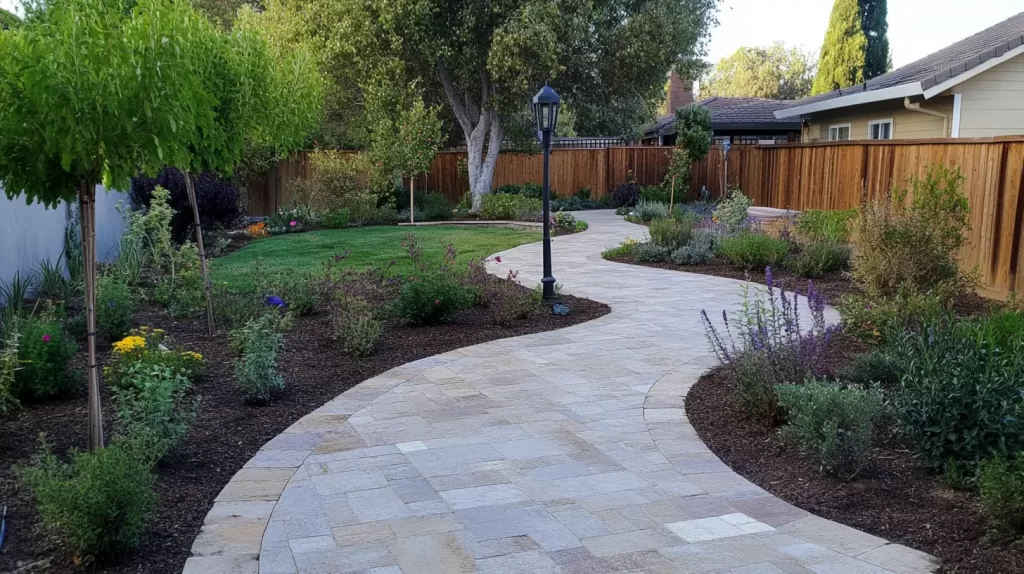
How Much Does a DIY Walkway Really Cost?
When planning a DIY walkway, understanding the potential costs is crucial to effectively manage your budget. Below are some common materials used for walkways, along with their estimated costs:
Pea Gravel Walkways
Pea gravel is one of the most affordable options for creating a functional and attractive path.
- Material Cost: Pea gravel typically costs between $1 and $3.15 per square foot. For a 35-foot-long, 4-foot-wide walkway (140 square feet), the gravel would cost approximately $140 to $441.
- Additional Materials: To prevent weed growth and maintain the walkway’s integrity, you’ll need landscape fabric, which costs about $0.45 per square foot. For the same 140-square-foot path, this would add around $63.
- Total Estimated Cost: Combining gravel and landscape fabric, the total material cost ranges from $203 to $504.
Concrete Walkways
Concrete offers a durable and versatile solution for walkways, with costs varying based on design complexity.
- Basic Concrete: Plain concrete walkways cost between $6 and $10 per square foot. For a 140-square-foot path, this totals approximately $840 to $1,400.
- Stamped or Colored Concrete: For added aesthetic appeal, stamped or colored concrete ranges from $10 to $12 per square foot, bringing the total to about $1,400 to $1,680 for the same area.
- Total Estimated Cost: Depending on the finish, expect to spend between $840 and $1,680 on materials.
Paver Walkways
Pavers provide a customizable and visually appealing option, though they come at a higher cost.
- Material Cost: Concrete pavers are priced between $8 and $15 per square foot. For a 140-square-foot walkway, this amounts to approximately $1,120 to $2,100.
- Additional Materials: You’ll need crushed gravel for the base and paver sand for leveling. Crushed gravel costs about $800 per pallet (covering roughly 100 square feet), so for 140 square feet, you’d need 1.4 pallets, totaling around $1,120. Paver sand costs approximately $5 per bag; assuming one bag covers 10 square feet, you’d need 14 bags, totaling $70.
- Total Estimated Cost: Including pavers, gravel, and sand, the total material cost ranges from $2,310 to $3,290.
Brick Walkways
Brick walkways exude timeless charm but are among the more expensive options.
- Material Cost: Brick pavers cost between $10 and $20 per square foot. For a 140-square-foot path, this totals approximately $1,400 to $2,800.
- Additional Materials: Similar to paver walkways, you’ll need crushed gravel and paver sand. Using the previous estimates, gravel would cost about $1,120, and sand would be around $70.
- Total Estimated Cost: Combining bricks, gravel, and sand, expect to spend between $2,590 and $3,990 on materials.
Additional Considerations
- Tools and Equipment: Depending on the complexity of your project, you may need tools such as shovels, rakes, a tamper, and a level. Renting or purchasing these can add to your overall cost.
- Labor: While DIY projects save on labor expenses, consider the time and effort required. Some materials, like concrete and pavers, demand more labor-intensive installation compared to pea gravel.
- Site Preparation: Clearing and leveling the site, as well as installing edging or borders, can incur additional costs.
By carefully assessing these factors and choosing materials that align with your budget and desired aesthetic, you can create a beautiful and cost-effective walkway that enhances your outdoor space.
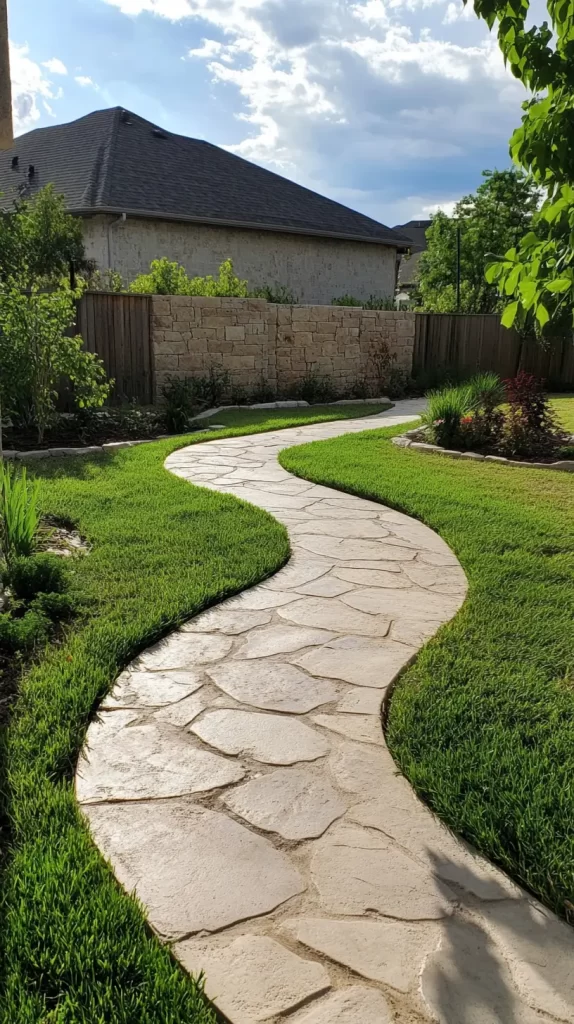
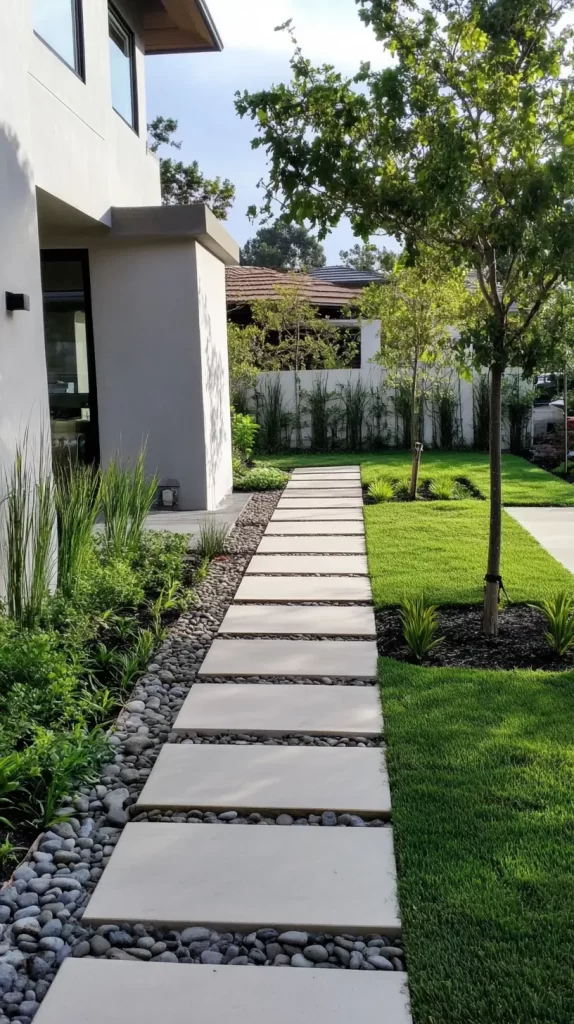
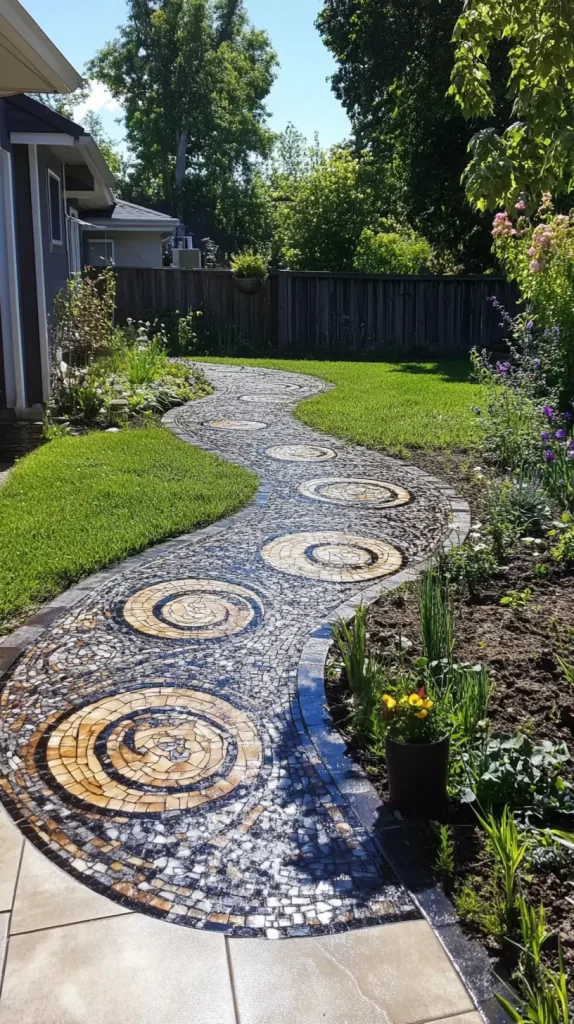
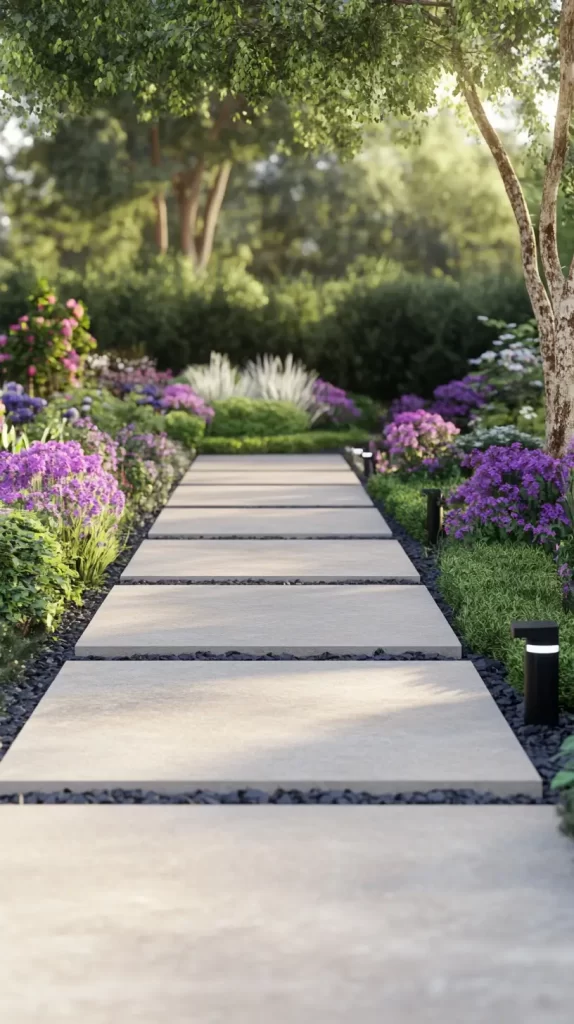
Final Thoughts
Walkways don’t need to be expensive or stressful. You can make them cute, useful, and sturdy without spending a ton. From gravel to mulch to pavers to bricks, there are plenty of cheap walkway ideas diy lovers can pull off. And most of these can be done in a weekend.
Whether you’re guiding people to your front door, around your garden, or just through your yard, these ideas work. Mix materials. Add flowers. Try different layouts. You don’t have to follow rules. Just make something that fits your space and your style.
Even the simplest walkway gets better with a little thought. A few plants, some lights, or a fun paint touch can change the feel fast. And that’s the best part. These projects are flexible and fun. You’re in charge. You get to build something that works for your life.
If you’ve been thinking about fixing up your yard or adding a path, now’s the time. Grab some gravel or bricks. Dig out a little space. Take one step at a time. This is your yard—and it should feel like it.
And when you’re ready to show it off, Pinterest is full of extra ideas to try. But hopefully, you already feel ready to grab some supplies and get started. You’ve got the info. Now all that’s left is to do it.

